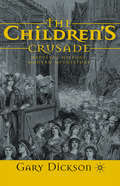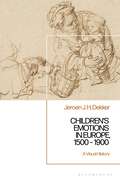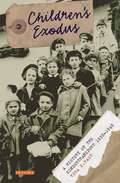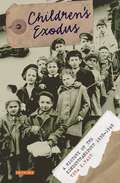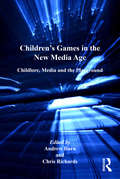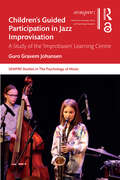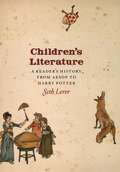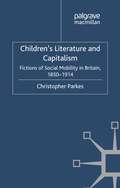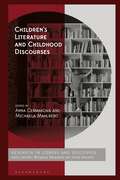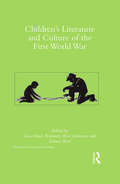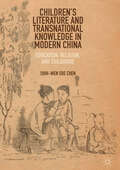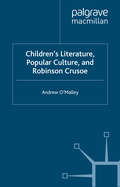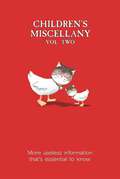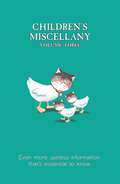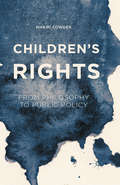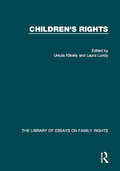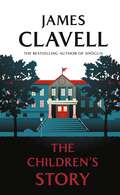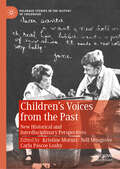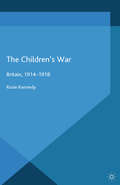- Table View
- List View
The Children's Crusade: Medieval History, Modern Mythistory
by G. DicksonThe Children's Crusade was possibly the most extraordinary event in the history of the crusades. The first modern study in English of this popular crusade sheds new light on its history and offers new perspectives on its supposedly dismal outcome. Its richly re-imagined history and mythistory is explored from the thirteenth century to present day.
Children’s Emotions in Europe, 1500 – 1900: A Visual History
by Professor Jeroen J. DekkerThis book gives you the historical sensation of coming face to face with the bodily expression and regulation of children's emotions over time. The study does this by encouraging you to look through the eyes of well-known artists, like Albrecht Dürer, Domenico Ghirlandaio, Jan Steen, Antony van Dyck, Rembrandt, and Titian in early modern Europe, and Jean-Baptiste Siméon Chardin, Thomas Lawrence,Jean-Honoré Fragonard, Philipp Otto Runge, Willem Bartel van der Kooi, Paul Gauguin, Auguste Renoir, and Jozef Israëls in the late 18th and 19th centuries. These sources are supplemented by works from less-famous artists, as well as popular emblem books, child-advice manuals, observations from the emerging child sciences, and personal documents. Jeroen Dekker observes children's emotions mainly in the child's world and in the domestic emotional space, and connects them with history's ongoing, underlying discourse on education and the emotions. This discourse was developed by theologians, philosophers, and moralists like Augustine, Aquinas, Erasmus, Descartes, Jacob Cats, John Locke and Jean-Jacques Rousseau, by Romantic educationalists like Friedrich Fröbel and Ellen Key, and by scientists like Charles Darwin and William James who emphasized the biological instead of the moral fundament of children's emotions. The story of children's emotions is told in the context of cultural movements like the Renaissance, Humanism, the Reformation, the Enlightenment, Romanticism, and the starting Age of Child Science. Children's Emotions in Europe, 1500 – 1900 crucially highlights the continuous co-existence of regulation-oriented and child-oriented educational views on children's emotions.
Children’s Emotions in Europe, 1500 – 1900: A Visual History
by Professor Jeroen J. DekkerThis book gives you the historical sensation of coming face to face with the bodily expression and regulation of children's emotions over time. The study does this by encouraging you to look through the eyes of well-known artists, like Albrecht Dürer, Domenico Ghirlandaio, Jan Steen, Antony van Dyck, Rembrandt, and Titian in early modern Europe, and Jean-Baptiste Siméon Chardin, Thomas Lawrence,Jean-Honoré Fragonard, Philipp Otto Runge, Willem Bartel van der Kooi, Paul Gauguin, Auguste Renoir, and Jozef Israëls in the late 18th and 19th centuries. These sources are supplemented by works from less-famous artists, as well as popular emblem books, child-advice manuals, observations from the emerging child sciences, and personal documents. Jeroen Dekker observes children's emotions mainly in the child's world and in the domestic emotional space, and connects them with history's ongoing, underlying discourse on education and the emotions. This discourse was developed by theologians, philosophers, and moralists like Augustine, Aquinas, Erasmus, Descartes, Jacob Cats, John Locke and Jean-Jacques Rousseau, by Romantic educationalists like Friedrich Fröbel and Ellen Key, and by scientists like Charles Darwin and William James who emphasized the biological instead of the moral fundament of children's emotions. The story of children's emotions is told in the context of cultural movements like the Renaissance, Humanism, the Reformation, the Enlightenment, Romanticism, and the starting Age of Child Science. Children's Emotions in Europe, 1500 – 1900 crucially highlights the continuous co-existence of regulation-oriented and child-oriented educational views on children's emotions.
Children's Exodus: A History of the Kindertransport
by Vera K. FastIn the months leading up to the outbreak of World War Two, Britain rushed to evacuate nearly 10,000 Jewish children from the Nazi occupied territories. Through the unprecedented cooperation of religious and governmental organizations, the Kindertransport spared thousands of Jewish children from the terror of the Third Reich and provided them with host families in Britain. "Children's Exodus" offers an in-depth look at the people and politics behind the various chains of rescue as well as the personal narratives of the children who left everything behind in the hope of finding safety. Drawing on unpublished interviews, journals, and articles, Vera K. Fast examines the religious and political tensions that emerged throughout the migration and at times threatened to bring operations to a halt. "Children's Exodus" captures the life-affirming stories of child refugees with vivid detail and examines the motivations - religious or otherwise - of the people that orchestrated one of the greatest rescue missions of all time.
Children's Exodus: A History of the Kindertransport
by Vera K. FastAs the Holocaust loomed on the horizon, Britain rushed to evacuate nearly 10,000 Jewish children from the Nazi occupied territories in the months leading up to the outbreak of the Second World War. Through the unprecedented cooperation of religious and governmental organizations, the Kindertransport spared these children from the terror of the Third Reich and provided them with host families throughout Britain. 'Children's Exodus' offers an in-depth look at the people and politics behind the various chains of rescue as well as the personal narratives of the children who left everything behind in hopes of finding safety. For the children who faced prosecution at the hands of the Nazis, the road to England took many forms. Vera K. Fast's account includes a diverse array of narratives which offer inspiring tales of endurance and survival in the face of extermination. Separated from their heritage and history, child refugees were forced to look inward for answers to lingering questions about their own religious identity as they struggled to adapt to their foreign surroundings. Drawing on unpublished interviews, journals, and articles, author Vera K. Fast examines the religious and political tensions that emerged throughout the migration and at times threatened to bring operations to a halt. 'Children's Exodus' explores the aftermath of the Refugee Children Movement as well as the subsequent attempts to reunite the fragmented Jewish community. The recently released records of Rabbi Schonfeld provide rare insight into the Othodox Jewish response to the Kindertransport movement. His papers document the search for the thousands of 'hidden Jews' who remained scattered throughout Europe in the years following the war as well as his controversial methods for bringing them to England. The book also provides a unique assessment of the second wave of the Kindertransport, which took place in 1945, to rescue the young survivors of the Holocaust.Vera K. Fast captures the life-affirming stories of child refugees with vivid detail and examines the motivations - religious or otherwise - of the organizations that orchestrated one of the greatest rescue missions of all time.
Children's Games in the New Media Age: Childlore, Media and the Playground (Studies in Childhood, 1700 to the Present)
by Andrew Burn Chris RichardsThe result of a unique research project exploring the relationship between children's vernacular play cultures and their media-based play, this collection challenges two popular misconceptions about children's play: that it is depleted or even dying out and that it is threatened by contemporary media such as television and computer games. A key element in the research was the digitization and analysis of Iona and Peter Opie's sound recordings of children's playground and street games from the 1970s and 1980s. This framed and enabled the research team's studies both of the Opies' documents of mid-twentieth-century play culture and, through a two-year ethnographic study of play and games in two primary school playgrounds, contemporary children's play cultures. In addition the research included the use of a prototype computer game to capture playground games and the making of a documentary film. Drawing on this extraordinary data set, the volume poses three questions: What do these hitherto unseen sources reveal about the games, songs and rhymes the Opies and others collected in the mid-twentieth century? What has happened to these vernacular forms? How are the forms of vernacular play that are transmitted in playgrounds, homes and streets transfigured in the new media age? In addressing these questions, the contributors reflect on the changing face of childhood in the twenty-first century - in relation to questions of gender and power and with attention to the children's own participation in producing the ethnographic record of their lives.
Children's Games in the New Media Age: Childlore, Media and the Playground (Studies in Childhood, 1700 to the Present)
by Andrew Burn Chris RichardsThe result of a unique research project exploring the relationship between children's vernacular play cultures and their media-based play, this collection challenges two popular misconceptions about children's play: that it is depleted or even dying out and that it is threatened by contemporary media such as television and computer games. A key element in the research was the digitization and analysis of Iona and Peter Opie's sound recordings of children's playground and street games from the 1970s and 1980s. This framed and enabled the research team's studies both of the Opies' documents of mid-twentieth-century play culture and, through a two-year ethnographic study of play and games in two primary school playgrounds, contemporary children's play cultures. In addition the research included the use of a prototype computer game to capture playground games and the making of a documentary film. Drawing on this extraordinary data set, the volume poses three questions: What do these hitherto unseen sources reveal about the games, songs and rhymes the Opies and others collected in the mid-twentieth century? What has happened to these vernacular forms? How are the forms of vernacular play that are transmitted in playgrounds, homes and streets transfigured in the new media age? In addressing these questions, the contributors reflect on the changing face of childhood in the twenty-first century - in relation to questions of gender and power and with attention to the children's own participation in producing the ethnographic record of their lives.
Children’s Guided Participation in Jazz Improvisation: A Study of the ‘Improbasen’ Learning Centre (SEMPRE Studies in The Psychology of Music)
by Guro Gravem JohansenImprobasen is a Norwegian private learning centre that offers beginner's instrumental tuition within jazz improvisation for children between the ages of 7 and 15. This book springs out of a two-year ethnographic study of the teaching and learning activity at Improbasen, highlighting features from the micro-interactions within the lessons, the organisation of Improbasen, and its international activity. Music teachers, students, and scholars within music education as well as jazz research will benefit from the perspectives presented in the book, which shows how children systematically acquire tools for improvisation and shared codes for interplay. Through a process of guided participation in jazz culture, even very young children are empowered to take part in a global, creative musical practice with improvisation as an educational core. This book critically engages in current discussions about jazz pedagogy, inclusion and gender equity, beginning instrumental tuition, creativity, and authenticity in childhood.
Children’s Guided Participation in Jazz Improvisation: A Study of the ‘Improbasen’ Learning Centre (SEMPRE Studies in The Psychology of Music)
by Guro Gravem JohansenImprobasen is a Norwegian private learning centre that offers beginner's instrumental tuition within jazz improvisation for children between the ages of 7 and 15. This book springs out of a two-year ethnographic study of the teaching and learning activity at Improbasen, highlighting features from the micro-interactions within the lessons, the organisation of Improbasen, and its international activity. Music teachers, students, and scholars within music education as well as jazz research will benefit from the perspectives presented in the book, which shows how children systematically acquire tools for improvisation and shared codes for interplay. Through a process of guided participation in jazz culture, even very young children are empowered to take part in a global, creative musical practice with improvisation as an educational core. This book critically engages in current discussions about jazz pedagogy, inclusion and gender equity, beginning instrumental tuition, creativity, and authenticity in childhood.
Children's Literature: A Reader's History, from Aesop to Harry Potter
by Seth LererEver since children have learned to read, there has been children’s literature. Children’s Literature charts the makings of the Western literary imagination from Aesop’s fables to Mother Goose, from Alice's Adventures in Wonderland to Peter Pan, from Where the Wild Things Are to Harry Potter. The only single-volume work to capture the rich and diverse history of children’s literature in its full panorama, this extraordinary book reveals why J. R. R. Tolkien, Dr. Seuss, Laura Ingalls Wilder, Beatrix Potter, and many others, despite their divergent styles and subject matter, have all resonated with generations of readers. Children’s Literature is an exhilarating quest across centuries, continents, and genres to discover how, and why, we first fall in love with the written word. “Lerer has accomplished something magical. Unlike the many handbooks to children’s literature that synopsize, evaluate, or otherwise guide adults in the selection of materials for children, this work presents a true critical history of the genre. . . . Scholarly, erudite, and all but exhaustive, it is also entertaining and accessible. Lerer takes his subject seriously without making it dull.”—Library Journal (starred review) “Lerer’s history reminds us of the wealth of literature written during the past 2,600 years. . . . With his vast and multidimensional knowledge of literature, he underscores the vital role it plays in forming a child’s imagination. We are made, he suggests, by the books we read.”—San Francisco Chronicle “There are dazzling chapters on John Locke and Empire, and nonsense, and Darwin, but Lerer’s most interesting chapter focuses on girls’ fiction. . . . A brilliant series of readings.”—Diane Purkiss, Times Literary Supplement
Children's Literature and Capitalism: Fictions of Social Mobility in Britain, 1850-1914 (Critical Approaches to Children's Literature)
by C. ParkesAfter the first phase of industrialization in Britain, the child emerged as both a victim of and a threat to capitalism. This book explores the changing relationship between the child and capitalist society in the works of some of the most important writers of children's and young-adult texts in the Victorian and Edwardian periods.
Children’s Literature and Childhood Discourses: Exploring Identity through Fiction (Corpus and Discourse)
by Anna Cermakova and Michaela MahlbergChildren's literature shapes what children learn about the world. It reflects social values, norms, and stereotypes. This book offers fresh insights into some of the key issues in fiction for children, from the representation of gender to embodied cognition and the translation of children's literature.Connecting classic children's texts such as Alice in Wonderland with contemporary fiction including Murder Most Unladylike, the book innovatively brings together perspectives from corpus linguistics, stylistics, cognitive linguistics, literary and cultural studies, and human geography. It explores approaches to experiencing fiction, as well as methods for the study of literary texts. Childhood discourses are investigated through the materiality of texts, the spaces that literature takes up in libraries, the cultural history of fiction moulded through performances, as well as reading environments that shape childhood experiences, such as fashion and urban spaces.Children's Literature and Childhood Discourses emphasizes the crucial link between fictional stories and real life.
Children’s Literature and Childhood Discourses: Exploring Identity through Fiction (Corpus and Discourse)
Children's literature shapes what children learn about the world. It reflects social values, norms, and stereotypes. This book offers fresh insights into some of the key issues in fiction for children, from the representation of gender to embodied cognition and the translation of children's literature.Connecting classic children's texts such as Alice in Wonderland with contemporary fiction including Murder Most Unladylike, the book innovatively brings together perspectives from corpus linguistics, stylistics, cognitive linguistics, literary and cultural studies, and human geography. It explores approaches to experiencing fiction, as well as methods for the study of literary texts. Childhood discourses are investigated through the materiality of texts, the spaces that literature takes up in libraries, the cultural history of fiction moulded through performances, as well as reading environments that shape childhood experiences, such as fashion and urban spaces.Children's Literature and Childhood Discourses emphasizes the crucial link between fictional stories and real life.
Children's Literature and Culture of the First World War (Children's Literature and Culture)
by Emma Short Lissa Paul Rosemary R. JohnstonBecause all wars in the twenty-first century are potentially global wars, the centenary of the first global war is the occasion for reflection. This volume offers an unprecedented account of the lives, stories, letters, games, schools, institutions (such as the Boy Scouts and YMCA), and toys of children in Europe, North America, and the Global South during the First World War and surrounding years. By engaging with developments in Children’s Literature, War Studies, and Education, and mining newly available archival resources (including letters written by children), the contributors to this volume demonstrate how perceptions of childhood changed in the period. Children who had been constructed as Romantic innocents playing safely in secure gardens were transformed into socially responsible children actively committing themselves to the war effort. In order to foreground cross-cultural connections across what had been perceived as ‘enemy’ lines, perspectives on German, American, British, Australian, and Canadian children’s literature and culture are situated so that they work in conversation with each other. The multidisciplinary, multinational range of contributors to this volume make it distinctive and a particularly valuable contribution to emerging studies on the impact of war on the lives of children.
Children's Literature and Culture of the First World War (Children's Literature and Culture)
by Emma Short Lissa Paul Rosemary Ross JohnstonBecause all wars in the twenty-first century are potentially global wars, the centenary of the first global war is the occasion for reflection. This volume offers an unprecedented account of the lives, stories, letters, games, schools, institutions (such as the Boy Scouts and YMCA), and toys of children in Europe, North America, and the Global South during the First World War and surrounding years. By engaging with developments in Children’s Literature, War Studies, and Education, and mining newly available archival resources (including letters written by children), the contributors to this volume demonstrate how perceptions of childhood changed in the period. Children who had been constructed as Romantic innocents playing safely in secure gardens were transformed into socially responsible children actively committing themselves to the war effort. In order to foreground cross-cultural connections across what had been perceived as ‘enemy’ lines, perspectives on German, American, British, Australian, and Canadian children’s literature and culture are situated so that they work in conversation with each other. The multidisciplinary, multinational range of contributors to this volume make it distinctive and a particularly valuable contribution to emerging studies on the impact of war on the lives of children.
Children’s Literature and Transnational Knowledge in Modern China: Education, Religion, and Childhood
by Shih-Wen Sue ChenThis book examines the development of Chinese children’s literature from the late Qing to early Republican era. It highlights the transnational flows of knowledge, texts, and cultures during a time when children’s literature in China and the West was developing rapidly. Drawing from a rich archive of periodicals, novels, tracts, primers, and textbooks, the author analyzes how Chinese children’s literature published by Protestant missionaries and Chinese educators in the late nineteenth and early twentieth centuries presented varying notions of childhood. In this period of dramatic transition from the dynastic Qing empire to the new Republican China, young readers were offered different models of childhood, some of which challenged dominant Confucian ideas of what it meant to be a child. This volume sheds new light on a little-explored aspect of Chinese literary history. Through its contributions to the fields of children’s literature, book history, missionary history, and translation studies, it enhances our understanding of the negotiations between Chinese and Western cultures that shaped the publication and reception of Chinese texts for children.
Children's Literature, Popular Culture, and Robinson Crusoe (Critical Approaches to Children's Literature)
by A. O'MalleyThis study of the afterlife of Robinson Crusoe offers insights into the continued popularity and relevance of Crusoe's story and how modern conceptions of childhood are shaped by nostalgia and ideas of 'the popular'. Examining many adaptations in a variety of formats, it reconsiders the place Crusoe has occupied in our culture for three centuries.
Children's Miscellany: Volume 2
by Dominique EnrightThe sequel to the best-selling Children's Miscellany. Packed full of even more, even smarter, even stranger facts, Children's Miscellany Volume Two includes Shakespearian insults, the longest place names in the world, five ways to de-smell your trainers and how to hypnotize a chicken!
Children's Miscellany: Volume 3
by Dominique EnrightThe sequel to the bestselling Children's Miscellany: Volume One and Children's Miscellany: Volume Two. Packed full of even more, even smarter, even stranger useless information. Discover the secrets of history, the animal kingdom,plants, planets, people and much, much more...
Children's Rights: From Philosophy to Public Policy
by Mhairi CowdenDespite the existence of the UN Convention on the Rights of the Child there still exists a debate on whether children can really hold rights. This book presents a clear theory of children's rights by examining controversial case studies. The author presents a pathway to translating rights into practical social and political instruments for change.
Children's Rights
by Ursula KilkellyThe articles in this volume shed light on some of the major tensions in the field of children‘s rights (such as the ways in which children‘s best interests and respect for their autonomy can be reconciled), challenges (such as how the CRC can be made a reality in the lives of children in the face of ignorance, apathy or outright opposition) and critiques (whether children‘s rights are a Western imposition or a successful global consensus). Along the way, the writing covers a myriad of issues, encompassing the opposition to the CRC in the US; gay parenting: Dr Seuss‘s take on children‘s autonomy; the voice of neonates on their health care; the role of NGO in supporting child labourers in India, and young people in detention and more.
Children's Rights: A Comparative Perspective (Issues In Law And Society Ser. #2)
by Ursula KilkellyThe articles in this volume shed light on some of the major tensions in the field of children‘s rights (such as the ways in which children‘s best interests and respect for their autonomy can be reconciled), challenges (such as how the CRC can be made a reality in the lives of children in the face of ignorance, apathy or outright opposition) and critiques (whether children‘s rights are a Western imposition or a successful global consensus). Along the way, the writing covers a myriad of issues, encompassing the opposition to the CRC in the US; gay parenting: Dr Seuss‘s take on children‘s autonomy; the voice of neonates on their health care; the role of NGO in supporting child labourers in India, and young people in detention and more.
The Children's Story
by James Clavell"What does 'allegiance' mean?" the New Teacher asked, hand over her heart.In this classic and chilling tale about an elementary school classroom in post-war occupied America, James Clavell brings to light the vulnerability of children and the power educators have to shape and change young minds. Originally written in the Cold War era, Clavell's extraordinary and enduringly relevant allegory on the impressionability of the human mind is still read in schools around the globe today, and is a call to every person to keep questioning and keep learning.
Children’s Voices from the Past: New Historical and Interdisciplinary Perspectives (Palgrave Studies in the History of Childhood)
by Kristine Moruzi Nell Musgrove Carla Pascoe LeahyThis book explores a central methodological issue at the heart of studies of the histories of children and childhood. It questions how we understand the perspectives of children in the past, and not just those of the adults who often defined and constrained the parameters of youthful lives. Drawing on a range of different sources, including institutional records, interviews, artwork, diaries, letters, memoirs, and objects, this interdisciplinary volume uncovers the voices of historical children, and discusses the challenges of situating these voices, and interpreting juvenile agency and desire. Divided into four sections, the book considers children's voices in different types of historical records, examining children's letters and correspondence, as well as multimedia texts such as film, advertising and art, along with oral histories, and institutional archives.
The Children's War: Britain, 1914-1918
by R. KennedyBritish children were mobilised for total war in 1914-18. It dominated their school experience and they enjoyed it as a source of entertainment. Their support was believed to be vital for Britain's present and future but their participation was motivated by a desire to remain connected to their absent fathers and brothers.
